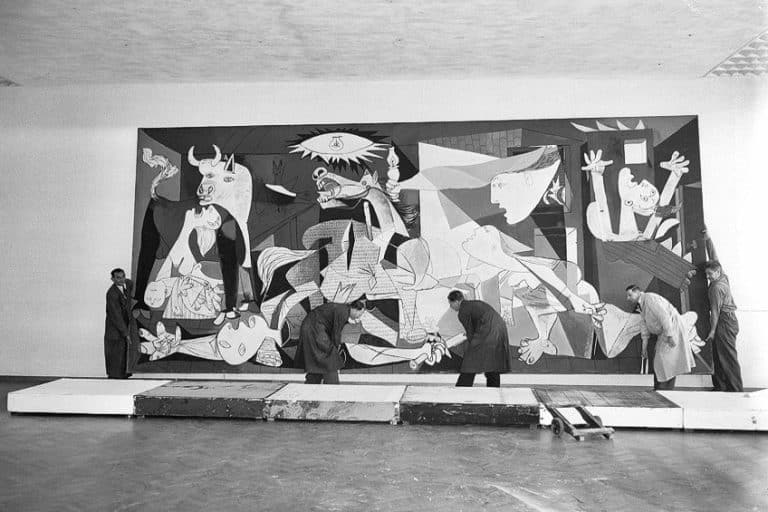“Swans Reflecting Elephants” by Salvador Dalí – An Analysis
Swans Reflecting Elephants is a prominent surrealist painting by Salvador Dalí created in 1937. This artwork is known for its use of double images which was a hallmark of Dalí’s oeuvre during his Paranoiac-critical period, a concept he developed influenced by the psychoanalytic theories of Sigmund Freud. In this painting, Dalí explores the subconscious and the irrational, employing optical illusions to transform serene swans on a lake into the massive forms of elephants upon reflection. This masterpiece continues to mesmerize audiences, inviting contemplation on the nature of reality and the power of artistic interpretation.
Table of Contents
Key Takeaways
- Salvador Dalí’s Swans Reflecting Elephants employs double imagery to merge dream and reality.
- Created in 1937, this painting is a key work from Dalí’s Paranoiac-critical period.
- The painting represents a significant contribution to the Surrealist movement.
Historical Context
| Artist | Salvador Dalí (1904 – 1989) |
| Date Created | 1937 |
| Medium | Oil on canvas |
| Genre | Surrealism |
| Period/Movement | Surrealist movement |
| Dimensions (cm) | 51 x 77 |
| Series/Versions | N/A |
| Where Is It Housed? | Private collection |
| What It Is Worth | Estimated to be in the millions (auction prices vary) |
In the realm of 20th-century art, Salvador Dalí is often revered for his striking contributions, particularly within the Surrealist Movement. Swans Reflecting Elephants encapsulates the innovative spirit of this era, strategically positioned within a historical tapestry of cultural and intellectual upheaval. Surrealism, emerging from the aftermath of World War I and influenced by Freudian theories, sought to challenge rational thought and conventional aesthetics. Salvador Dalí, a pivotal figure in the movement, drew inspiration from encounters with luminaries like Picasso and Freud, shaping his distinctive artistic vision.
His Paranoiac-Critical Period in the 1930s yielded masterpieces like Swans Reflecting Elephants, showcasing his adeptness at merging reality with dream-like visions.

Through this technique, Dalí and his Surrealist peers aimed to unravel the mysteries of the subconscious, leaving an enduring imprint on 20th-century art. The double imagery in Swans Reflecting Elephants not only epitomizes Dalí’s personal methodology but also symbolizes Surrealism’s profound exploration of the blurred boundaries between dreams and reality, reshaping the landscape of modern art and inviting profound psychological reflection.
Formal Analysis
Swans Reflecting Elephants is a celebrated oil on canvas painting by Salvador Dalí, depicting a masterful blend of reflection and metamorphosis. This section unpacks the visual intricacies and symbolisms that Dalí employs, alongside his technical prowess in composition.
Interpretation of Imagery
In Swans Reflecting Elephants, a clear lake paints the mirror image of swans in water, which upon closer inspection, transitions into elephants. The illusion is facilitated by Dalí’s use of the Paranoia-Critical Method, which invites viewers to experience the duality of images.
The painting’s foreground hosts the swans, while the reflected elephants occupy the background, merging land with water to breach the divide between reality and surreality.
Symbolism and Themes
Dalí’s painting is replete with symbolism and themes that delve into the depths of time, memory, and nature. The swans symbolize grace and beauty, whereas the imposing elephants may represent strength and memory. By overlapping these elements, Dalí introduces themes of transformation and metamorphosis. The reference to Narcissus in the reflective quality of the lake recalls the myth’s themes of reflection and self-obsession.
This is analogous to Dalí’s own exploration of the subconscious mind.
Technique and Composition
The composition of Swans Reflecting Elephants features meticulous brushwork and a harmonious palette of colors that enhance the painting’s dreamlike quality. Dalí applies fine detail in the feathers of the swans and the skin of the elephants to reinforce the visual illusion. This double imagery anchors the surreal landscape, marrying the otherwise tranquil nature scene with a jarring metamorphosis.
It also affirms Dalí’s aim in “The Conquest of the Irrational” to transcend the typical bounds of perception through art.
Dalí’s Legacy and Exhibition
Salvador Dalí’s iconic work, Swans Reflecting Elephants, has played a pivotal role in his legacy, showcasing his mastery in surrealism through public exhibitions and private collections. The painting is one of many that cement Dalí’s influence in contemporary art and culture.

Private Collections and Public Exhibitions
Swans Reflecting Elephants has transitioned between private collections and public exhibitions since its creation in 1937. Notably, it has been housed in prestigious venues that uphold Dalí’s legacy through continuous display and curation. This piece, along with other critical works such as The Persistence of Memory (1931) and The Disintegration of the Persistence of Memory (1952 – 1954), often travels internationally for special exhibits, allowing a diverse audience to engage with Dalí’s vision.
- Private collections: Individuals and institutions have acquired Dalí’s paintings for private collections, which sometimes leads to public loans to museums and galleries. The ownership of these works, including Swans Reflecting Elephants, often remains private but can be found on temporary display in exhibitions around the world.
- Public exhibitions: Permanently located in museums such as the Salvador Dalí Museum in St. Petersburg, Florida, Dalí’s broader collections, including Lobster Telephone (1936) and The Discovery of America by Christopher Columbus (1958 – 1959), are available for public viewing. These institutions serve as cultural repositories of Dalí’s work and contribute to his enduring fame.
Cultural Impact
Dalí’s surreal compositions, characterized by vivid yet profound juxtapositions, have permeated the cultural zeitgeist. Swans Reflecting Elephants exemplifies this with its mirrored imagery that reveals elephants in the reflections of swans — a visual play that challenges perceptions.
The painting echoes the theme of dual reality, an element present in several works by Dalí, and has become a subject of fascination in art circles and beyond.
Influence Today
His contribution to surrealism and the visual arts resonates today, influencing contemporary artists and thinkers. Dalí’s work, including Swans Reflecting Elephants, remains a cornerstone in study programs and is frequently referenced in modern media. The painting’s technique and thematic depth are dissected in art schools, while its motifs are echoed in fashion, design, and pop culture. The lasting appeal of Dalí’s work ensures that it continues to inspire and evoke curiosity.

Swans Reflecting Elephants epitomizes Salvador Dalí’s surreal genius, captivating audiences with its blend of natural and fantastical imagery. Its enduring symbolism and meticulous technique invite endless interpretation, inviting viewers to explore the depths of their subconscious. Decades after its creation, the painting continues to inspire wonder and fascination, challenging perceptions and igniting the imagination. Through this masterpiece, Dalí beckons us to embrace the surreal, questioning reality and delving into the hidden landscapes of our minds.
Frequently Asked Questions
What Does the Use of Double Images Symbolize in Dalí’s Paintings?
Double images in Dalí’s work often represent the duality of reality and illusion. They invite viewers to consider multiple perspectives simultaneously and challenge the reliability of perception.
What Is the Significance of Reflection in Swans Reflecting Elephants?
Reflection in Swans Reflecting Elephants is a key element that illustrates transformation and the fluid nature of reality. The swans’ reflections as elephants in the water blur the lines between the concrete and the imagined.
How Does the Painting Reflect Salvador Dalí’s Artistic Evolution?
Swans Reflecting Elephants marks a period in Dalí’s career where he was deeply immersed in the exploration of the subconscious mind, illustrating his progression towards embedding complex symbolism and dreamlike imagery into his art.
Isabella studied at the University of Cape Town in South Africa and graduated with a Bachelor of Arts majoring in English Literature & Language and Psychology. Throughout her undergraduate years, she took Art History as an additional subject and absolutely loved it. Building on from her art history knowledge that began in high school, art has always been a particular area of fascination for her. From learning about artworks previously unknown to her, or sharpening her existing understanding of specific works, the ability to continue learning within this interesting sphere excites her greatly.
Her focal points of interest in art history encompass profiling specific artists and art movements, as it is these areas where she is able to really dig deep into the rich narrative of the art world. Additionally, she particularly enjoys exploring the different artistic styles of the 20th century, as well as the important impact that female artists have had on the development of art history.
Learn more about Isabella Meyer and the Art in Context Team.
Cite this Article
Isabella, Meyer, ““Swans Reflecting Elephants” by Salvador Dalí – An Analysis.” Art in Context. February 19, 2024. URL: https://artincontext.org/swans-reflecting-elephants-by-salvador-dali/
Meyer, I. (2024, 19 February). “Swans Reflecting Elephants” by Salvador Dalí – An Analysis. Art in Context. https://artincontext.org/swans-reflecting-elephants-by-salvador-dali/
Meyer, Isabella. ““Swans Reflecting Elephants” by Salvador Dalí – An Analysis.” Art in Context, February 19, 2024. https://artincontext.org/swans-reflecting-elephants-by-salvador-dali/.










